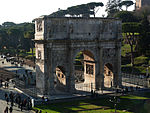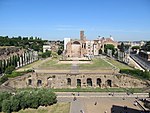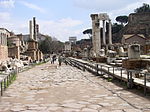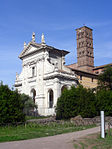Colosseo (Rome Metro)
1955 establishments in ItalyRailway stations opened in 1955Rome Metro Line B stationsRome Metro Line C stationsRome R. I Monti

Colosseo is a station on Line B of the Rome Metro. It was opened on 10 February 1955 and is located, as its name suggests, in the Monti rione on via del Colosseo near the Colosseum. The station is currently being expanded to be the new northern terminus of Metro's Line C. Its atrium houses mosaics from the Artemetro Roma Prize. They are by Pietro Dorazio (Italy), Kenneth Noland (United States) and Emil Schumacher (Germany). The main exit is on the lower level, in front of the Colosseum on the Piazza Del Colosseo and to the right of the Arch of Constantine, whilst the other exit is a second story one, located in the middle of the Largo Gaetana Agnesi park above the Piazza.
Excerpt from the Wikipedia article Colosseo (Rome Metro) (License: CC BY-SA 3.0, Authors, Images).Colosseo (Rome Metro)
Rome Municipio Roma I
Geographical coordinates (GPS) Address Nearby Places Show on map
Geographical coordinates (GPS)
| Latitude | Longitude |
|---|---|
| N 41.891388888889 ° | E 12.491388888889 ° |
Address
Rome, Municipio Roma I
Lazio, Italy
Open on Google Maps











